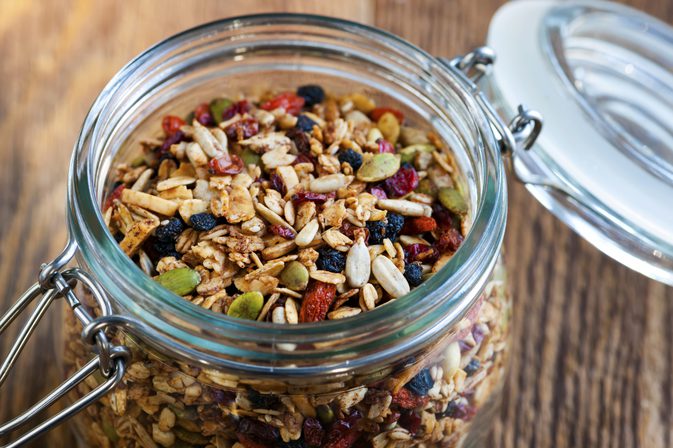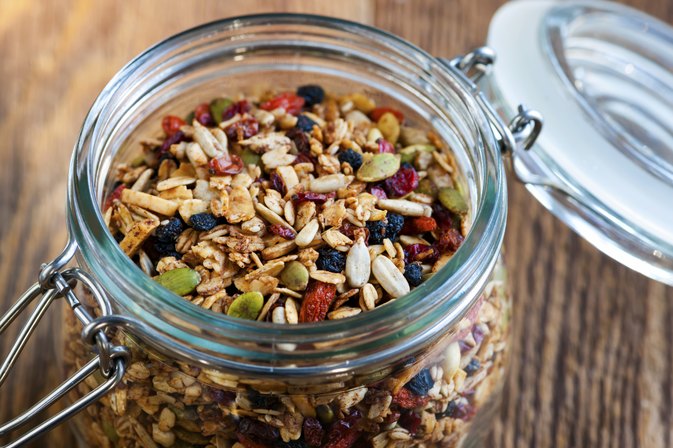How to Calculate Energy From Foods
The energy content of a food is a measure of how many calories the food contains. Your body needs a certain number of calories each day -- the required amount varies with your age, gender, weight status and activity level -- to maintain itself. Eating fewer than the required calories each day will result in weight loss, while eating more calories than your body requires on a regular basis will result in weight gain. Most foods have information about energy content printed on the label. However, for foods that don't, as long as you have access to information about the masses of different nutrients in the food, you can calculate energy content.
VIDEO OF THE DAY
Calculating Energy
Step 1
Multiply grams of carbohydrate in the food by 4 calories per gram. A calorie is a unit of how much energy is in a given amount of food, also called a kcal. Regardless of whether the carbohydrate in food is sugar or starch, all carbohydrates provide the body with 4 calories/gram, explains Dr. Lauralee Sherwood in her book "Human Physiology." Be sure not to include grams of fiber in your calculation -- despite the fact fiber is technically a carbohydrate, humans can't digest it, so it contains no energy.
Step 2
Multiply grams of protein in the food by 4 calories per gram. It does not matter what kind of protein a food contains; all proteins provide the same energy per unit mass, because they're all composed of the same basic building blocks, explain Drs. Reginald Garrett and Charles Grisham in their book "Biochemistry."
Step 3
Multiply grams of fat in the food by 9 calories per gram. Different kinds of fat vary slightly in their energy content -- some contain more than 9 calories/gram while others contain less. Regardless, the human diet tends to consist of a mixture of fats that average out to around 9 calories/gram, meaning that this relatively accurately assesses the energy content of a food due to fat.
Step 4
Add the energy from carbohydrate, protein and fat. The total, in calories, is the energy content of the food. This is the same information available on a nutritional label, for those foods that provide nutritional information.
YOU MIGHT ALSO LIKE
What Types of Foods Supply Carbohydrates, Proteins & Lipids?
Carbohydrates, protein and lipids are macronutrients that provide the body with calories. Nutrients are required for proper growth, metabolism and most body functions. While both macro and micronutrients are important for good health, macronutrients are necessary in large amounts. Carbohydrates and protein provide 4 kcal/g while fat provides the most energy, with 9 kcal/g. All foods fall into these three major categories of nutrients. It is important to understand how the body utilizes each nutrient, including their dietary sources and their functions within the body, in order to make healthy food choices as part of a well-balanced diet.
Carbohydrates
According to the Dietary Reference Intakes established by the U.S. Department of Agriculture, you should consume between 45 to 65 percent of your calories in the form of carbohydrates. Carbohydrates are converted into glucose in your body and carried through your bloodstream to your tissues and organs for energy. Glucose is stored as glycogen in the liver and muscles for later use. There are three types of carbohydrates. Simple sugar is the most basic carbohydrate found in fruits, vegetables and dairy products. Starch is made up of more than one sugar unit bound together and is found in whole grains, vegetables and beans. Dietary fiber is the carbohydrate found in plants that passes through the intestines undigested. It is present in fruits, vegetables, legumes, nuts, seeds and whole grains.
Protein
Protein is an essential component of every cell, tissue and organ in your body. They undergo a constant process of being broken down and replaced. The protein in your diet is digested into amino acids that are utilized in this process to rebuilt proteins. The U. S. Department of Agriculture recommends that you consume between 10 to 35 percent of your total calories from protein. Protein is found in varying amounts in meat, poultry, fish, dairy, eggs, legumes, vegetables, tofu, nuts, seeds and some grains. Protein from animal sources is known as complete protein because it contains all 20 essential amino acids, while protein from plant sources is called incomplete protein because it lacks one or more of the essential amino acids. Protein is responsible for growth and development, tissue repair, immune function, production of essential hormones and enzymes, energy and preserving lean muscle mass.
Lipids
Lipids, or fat, are needed by the body for normal growth and development, energy, cushioning for the organs, absorption of fat-soluble vitamins, maintenance of cell membranes and to provide taste, consistency and stability to food. According to the U. S. Department of Agriculture, you should consume 20 to 35 percent of your total calories from lipids. Fats are broken down into three main categories, saturated, unsaturated and trans fats. Saturated fats include foods such as meat, butter, lard and cream and are known to raise LDL, or bad cholesterol, levels. Unsaturated or healthy fats help to lower blood cholesterol. There are two types of unsaturated fats, mono and poly. Monounsaturated fats are found in olive and canola oil while polyunsaturated fats are found in sunflower, safflower, corn and soybean oils as well as in avocados, nuts and fatty fish such as salmon, herring and trout. Trans fats are found primarily in fried foods, snack foods and commercial baked goods. These fats have been found to increase your risk of developing heart disease.
Balanced Nutrition
Macronutrients are very important to a healthy diet. However, they are not the only nutritional concern. A well-balanced diet should also incorporate a variety of micronutrients such as vitamins and minerals. Micronutrients will help you meet your nutritional needs and prevent chronic disease. Additionally, it is important to consume an adequate amount of water. Your body requires water, between six to eight glasses per day, to function properly.
























